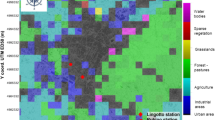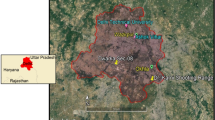Abstract
Concentrations of NO2, NO, and O3 from a rooftop monitoring station in Gothenburg, Sweden (2002–2006) were analysed to characterise NO2 pollution. [NO2] was shown to correlate strongly and non-linearly with [NO x ] (NO x = NO + NO2), in line with observations in other cities. The [NO2] to [NO x ] fraction fell initially with increasing [NO x ]. At [NO x ] levels >200 ppb, the decline in [NO2]/[NO x ] with increasing [NO x ] levelled out and [NO2]/[NO x ] converged towards approximately 0.15–0.16, independent of [NO x ]. Data from a traffic route site showed the same pattern. This value of [NO2]/[NO x ] at high [NO x ] can be interpreted as the NO2 fraction of the NO x emissions from vehicle exhaust. Situations with high NO x pollution and minimum [NO2]/[NO x ] were always associated with [O3] close to zero. Plotting [Ox] (Ox = NO2 + O3) vs. [NO x ] provided a strong linear correlation for situations dominated by local pollution ([NO]/[NO2]>1). The slope of the regression, a measure of the primary NO2 fraction in NO x emissions, was 0.13 during the day and 0.14 during the night. With stronger winds, the rooftop monitoring station became more similar, in terms of NO2 pollution, to a city street site and a traffic route site, although [NO2] was almost always higher at the street/traffic route locations. The EU standard for the annual average of [NO2] (40 μg m−3) was exceeded, while the hourly standard (200 μg m−3, not to be exceeded more than 18 times per year by 2010) was not exceeded at any of the sites.







Similar content being viewed by others
References
Air Quality Expert Group (2007). Trends in primary nitrogen dioxide in the UK. London: Department for the Environment, Food and Rural Affairs, Defra available at http://www.defra.gov.uk/environment/airquality/.
Arain, M. A., Blair, R., Finkelstein, N., Brook, J. R., Sahsuvaroglu, T., Beckerman, B., et al. (2007). The use of wind fields in a land use regression model to predict air pollution concentrations for health exposure studies. Atmospheric Environment, 41, 3453–3464.
Brimblecombe, P. (1996). Air composition and chemistry (2nd ed.). Cambridge: Cambridge University Press.
Carslaw, D. C. (2005). Evidence of an increasing NO2/NO x emissions ratio from road traffic emissions. Atmospheric Environment, 39, 4793–4802.
Carslaw, D. C., & Beevers, S. D. (2004). New directions: should road vehicle emissions legislation consider primary NO2? Atmospheric Environment, 38, 1233–1234.
Carslaw, D. C., Beevers, S. D., & Bell, M. C. (2007). Risks of exceeding the hourly EU limit value for nitrogen dioxide resulting form increased road transport emissions of primary nitrogen dioxide. Atmospheric Environment, 41, 2073–2082.
Chaloulakou, A., Mavroidis, I., & Gavril, I. (2008). Compliance with the annual NO2 air quality standard in Athens. Required NO x levels and expected health implications. Atmospheric Environment, 42, 454–465.
Clapp, L. J., & Jenkin, M. E. (2001). Analysis of the relationship between ambient levels of O3, NO2 and NO as a function of NO x in the UK. Atmospheric Environment, 38, 6391–6405.
Curtis, L., Rea, W., Smith-Willis, P., Fenyves, E., & Pan, Y. (2006). Adverse health effects of outdoor air pollutants. Environment International, 32, 815–830.
Derwent, R. G., Simmonds, P. G., Manning, A. J., & Spain, T. G. (2007). Trends over a 20-year period from 1987 to 2007 in surface ozone at the atmospheric research station, Mace Head, Ireland. Atmospheric Environment, 41, 9091–9098.
European Environment Agency. (2007). Air Pollution in Europe 1990–2004. EEA Report 2/2007. ISSN 1725-9177.
Gilbert, N. L., Woodhouse, S., Stieb, D. M., & Brook, J. R. (2003). Ambient nitrogen dioxide and distance from a major highway. The Science of the Total Environment, 312, 43–46.
Itano, Y., Bandow, H., Takenaka, N., Saitoh, Y., Asayama, A., & Fukuyama, J. (2007). Impact of NO x reduction on long-term trends in an urban atmosphere. Science of the Total Environment, 379, 46–55.
Jacobson, M. Z., Seinfeld, J. H., Carmichael, G. R., & Streets, D. G. (2004). The effect on photochemical smog on converting the U.S. fleet of gasoline vehicles to modern diesel vehicles. Geophysical Research Letters, 31, 1–5.
Janhäll, S., Olofsson, K. F. G., Andersson, P. U., Pettersson, J. B. C., & Hallquist, M. (2006). Evolution of the urban aerosol during winter temperature inversion episodes. Atmospheric Environment, 40, 5355–5366.
Jenkin, M. E. (2004). Analysis of sources and partitioning of oxidant in the UK—Part 2: contributions of nitrogen dioxide emissions and background ozone at a kerbside location in London. Atmospheric Environment, 38, 5131–5138.
Jenkin, M. E., Utembe, S. R., & Derwent, R. G. (2008). Modelling the impact of elevated primary NO2 and HONO emissions on regional scale oxidant formation in the UK. Atmospheric Environment, 42, 323–336.
Karlsson, P. E., Tang, L., Sundberg, J., Chen, D., Lindskog, A., & Pleijel, H. (2007). Increasing risk for negative ozone impacts on vegetation in northern Sweden. Environmental Pollution, 150, 96–106.
Leighton, P. A. (1961). Photochemistry of air pollution. New York: Academic.
Mazzeo, N. A., Venegas, L. E., & Choren, H. (2005). Analysis of NO, NO2, O3 and NO x concentrations measured at a green area of Buenos Aires City during wintertime. Atmospheric Environment, 39, 3055–3068.
Meleux, F., Solomon, F., & Giorgi, F. (2007). Increase in summer European ozone amounts due to climate changes. Atmospheric Environment, 41, 7577–7587.
Palmgren, F., Berkowicz, R., Hertel, O., & Vignati, E. (1996). Effects of reduction of NO x on the NO2 levels in urban streets. Science of the Total Environment, 189/190, 409–415.
Pleijel, H., Pihl Karlsson, G., & Binsell Gerdin, E. (2004). On the logarithmic relationship between NO2 concentration and the distance from a highroad. Science of the Total Environment, 332, 261–264.
Author information
Authors and Affiliations
Corresponding author
Rights and permissions
About this article
Cite this article
Pleijel, H., Klingberg, J. & Bäck, E. Characteristics of NO2 Pollution in the City of Gothenburg, South-West Sweden—Relation to NO x and O3 Levels, Photochemistry and Monitoring Location. Water Air Soil Pollut: Focus 9, 15–25 (2009). https://doi.org/10.1007/s11267-008-9201-y
Received:
Accepted:
Published:
Issue Date:
DOI: https://doi.org/10.1007/s11267-008-9201-y




